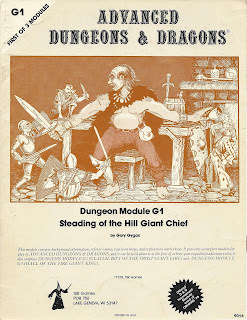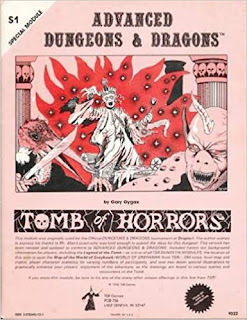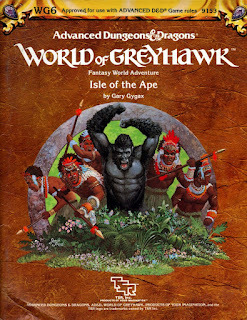An Observation about Gygax's Modules
 Between 1978 and 1985, TSR Hobbies published eighteen stand-alone adventure modules carrying the byline of Gary Gygax, starting with Steading of the Hill Giant Chief in 1978. Because it was the first of its kind, module G1 does not include a suggested level range on its cover. Instead, there is an interior section, labeled "CAUTION," that states the following:
Between 1978 and 1985, TSR Hobbies published eighteen stand-alone adventure modules carrying the byline of Gary Gygax, starting with Steading of the Hill Giant Chief in 1978. Because it was the first of its kind, module G1 does not include a suggested level range on its cover. Instead, there is an interior section, labeled "CAUTION," that states the following:Only strong characters should adventure into the Steading of the Hill Giant Chief if the party is but 3 or 4 strong. 6th or 7th level characters are suggested only when the party numbers 5 or more and only if most of the party is of higher level. The optimum mix for a group is 9 characters of various classes, with an average experience level of at least the 9th, and each should have 2 or 3 magic items.
The module's immediate sequels, The Glacial Rift of the Frost Giant Jarl and Hall of the Fire Giant King, include similar notes of caution that more or less reproduce what is stated above. When the three modules were collected together under one cover as Against the Giants in 1981, they were given a suggested level range of 8–12, which seems a bit higher than how I read Gygax's words.
Also published the same year was module D1, Descent into the Depths of the Earth, includes its own note of caution:
Those familiar with the previous modules in this scenario will be aware that they are designed for play only by players of above-average ability who have characters of high level – 9th or 10th minimum, counting multi-classed characters as roughly equal to a single classed character two levels higher than the character's higher level (three levels if triple classed) ... The module is designed for characters of about 10th level, with a party size of 7 to 9.
 Module D2,
Shrine of the Kuo-Toa
, offers similar advice, as does module D3, Vault of the Drow. Later reprintings of these modules (again, in 1981) would combine D1 and D2 and peg its level range at 9–14 and D3 at 10–14. (The conclusion to the Giants-Drow series, 1980's
Queen of the Demonweb Pits
, is largely by David C. Sutherland III but Gygax is given a "with" credit, since it's at least partially based on his ideas. In any event, it too is listed as being appropriate for character levels 10–14.)
Module D2,
Shrine of the Kuo-Toa
, offers similar advice, as does module D3, Vault of the Drow. Later reprintings of these modules (again, in 1981) would combine D1 and D2 and peg its level range at 9–14 and D3 at 10–14. (The conclusion to the Giants-Drow series, 1980's
Queen of the Demonweb Pits
, is largely by David C. Sutherland III but Gygax is given a "with" credit, since it's at least partially based on his ideas. In any event, it too is listed as being appropriate for character levels 10–14.)I find it interesting, as others undoubtedly have, that the first six modules TSR released for use with AD&D were all aimed at fairly high-level characters – roughly the 8–12 range. The seventh module released in 1978, Tomb of Horrors, doesn't include the same note of caution regarding levels. Instead, only that it is "A THINKING PERSON'S MODULE" with few monsters and whose challenges are meant to be" solved by brains and not brawn." That said, Tomb of Horrors does include a roster of pregenerated characters that range in level from 6 to 14. The later 1981 reprinting opts instead for a 10–14 range.
In 1979, TSR publishes The Village of Hommlet. Again, it has no level range listed on its cover, but "Notes for the Dungeon Master" explains that "this module is designed for beginning play" and that experienced players "should start new, 1st level characters." The cover of the 1981 reprint – a recurring theme! – states that it is for "Introductory to Novice Level." Later in 1979, Gygax's name would also appear on The Keep on the Borderlands. This is the first of his modules to specify a level range on its original cover, in this case 1–3.
 There's then a gap of three years before Gygax's name again graces the cover of a D&D module of any kind. That's when The Forgotten Temple of Tharizdun is published, with a stated level range of 5–10. The next year, 1983, we see Dungeonland and its sequel,
The Land Beyond the Magic Mirror
, both of which are suggested for levels 9–12. 1984's Mordenkainen's Fantastic Adventure is for the same level range, while 1985's
Isle of the Ape
, Gygax's last published adventure module for TSR, is for levels 18+.
There's then a gap of three years before Gygax's name again graces the cover of a D&D module of any kind. That's when The Forgotten Temple of Tharizdun is published, with a stated level range of 5–10. The next year, 1983, we see Dungeonland and its sequel,
The Land Beyond the Magic Mirror
, both of which are suggested for levels 9–12. 1984's Mordenkainen's Fantastic Adventure is for the same level range, while 1985's
Isle of the Ape
, Gygax's last published adventure module for TSR, is for levels 18+.Looking at the totality of his published output, as I've just done, it would seem that, by and large, Gygax wasn't all that interested in low-level adventures – or at least he wasn't interested in writing them. This might be because he simply found higher-level scenarios more compelling or because he felt there was a greater need for published examples of what higher-level play could be. Either way, he devoted himself to writing a significant number of modules in the 9th–12th level range, with only a small number of outliers.
Personally, I find this quite fascinating, if only because it runs counter to the conventional wisdom that Dungeons & Dragons, as a game line and as a product, benefits most from having lots of support for low to mid-level play. If you look at TSR's output over the years of its existence, you'll see lots of adventures in the levels 4–7 range and comparatively fewer at higher levels (though, again, there are outliers here and there). I know that my own personal preference has always been toward a similar middle span of levels and have often felt that every edition of D&D starts to creak after about level 9 or so, though Gygax would seem to have felt differently. If so, it makes me wonder all the more what his version of Second Edition might have looked like.
EDIT: I inexplicably left out both Expedition to the Barrier Peaks (8–12) and The Lost Caverns of Tsojcanth (6–10), two modules I like a great deal.
James Maliszewski's Blog
- James Maliszewski's profile
- 3 followers



